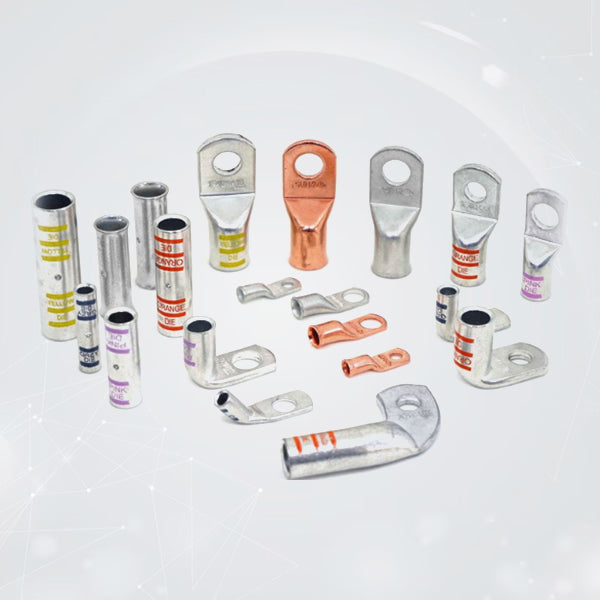
A Complete Guide to Matching 8 AWG Battery Cables with the Right Lug
If you're working on a vehicle, solar array, marine setup, or backup power system, you've likely used or considered using an 8 gauge battery cable. It’s one of the most versatile wire sizes available—durable, flexible, and capable of handling serious current without being too bulky to work with. But to get the most out of your setup, it's essential to pair that cable with the right lug.
In this complete guide, we’ll show you how to match your 8 AWG battery cable with the best 8 AWG cable lug—covering material choices, ring lug types, installation tips, and what to avoid. Whether you're an installer, technician, or DIY enthusiast, this blog is your go-to resource for solid, lasting electrical connections.
What Is an 8 Gauge Battery Cable?
Before diving into lugs, let’s start with the cable itself. An 8 gauge battery cable is a mid-sized wire, usually made of stranded copper for maximum flexibility and conductivity. It strikes the perfect balance between size and current capacity for a wide range of 12V and 24V applications.
Here’s why 8 AWG is so widely used:
- Ideal for Medium-Current Loads: This wire size can typically handle 40–50 amps depending on the insulation and environment, making it perfect for inverters, small motors, and battery interconnects.
- Highly Flexible Construction: Stranded copper construction allows for easy routing in tight engine bays, electrical cabinets, or along curved surfaces.
- Excellent Conductivity: Copper ensures minimal resistance and efficient power transfer, especially important for low-voltage DC systems.
- Versatile Applications: Commonly used in automotive, RV, solar, marine, and backup power installations.
- Compatible with a Wide Range of Lugs: Its popularity means it works with many styles of terminals, especially 8 gauge lugs like ring or spade connectors.
Why Lugs Matter
Even the highest-quality wire can’t do its job if it’s not properly terminated. That’s where 8 AWG cable lugs come in. The lug is the connection point between the cable and your battery, inverter, distribution panel, or grounding system. A mismatch or poor crimp can lead to a whole host of issues.
Here’s why choosing the right 8 gauge lugs is critical:
- Ensure Solid Electrical Contact: Lugs enable a secure and low-resistance connection that promotes steady power flow and minimizes voltage drop.
- Prevent Loose Connections: A properly sized and crimped 8 AWG ring lug holds tight, even in environments with constant vibration or movement.
- Enable Clean, Professional Installs: They keep your wiring organized, safe, and easy to service or troubleshoot later.
- Protect Against Corrosion and Moisture: When paired with heat shrink, lugs safeguard your connection from rust, oxidation, and environmental wear.
- Fit Precisely to Stud Sizes: With the right stud hole size, your lug sits flush on the terminal—no rattling, no arc risk.
Key Features to Look for in 8 AWG Cable Lugs
Now that we understand their importance, let’s break down how to pick the right 8 AWG cable lug for your job:
1. Wire Gauge Match
Start with the basics: your lug must be built specifically for 8 AWG wire. Don’t settle for “close enough” sizes—undersized lugs won’t fit, and oversized ones create a weak crimp that could come loose.
2. Material Quality
Look for high-conductivity bare copper lugs or tinned copper for added corrosion resistance. Bare copper provides excellent current flow and is ideal for dry, indoor use, while tinned copper is better for marine or outdoor environments.
3. Ring Lug Type
A ring lug has a closed loop that slips over a bolt or stud, providing the most secure connection. It’s the preferred choice for systems subject to vibration, like vehicles or boats. When searching for compatibility, use terms like "8 AWG ring lug" to find the exact fit.
4. Stud Hole Size
Common stud sizes for 8 AWG lugs include 1/4", 5/16", and 3/8". Make sure you know the bolt size on your terminal so the lug fits snugly. A poorly matched stud hole can lead to arc risk and overheating.
Recommended Product: SELTERM 8 AWG Bare Copper Lugs
For a worry-free connection, check out the SELTERM collection of 8 AWG bare copper lugs. These lugs are made from high-purity copper, UL listed for safety, and come in a range of stud sizes for easy installation.
✅ High-conductivity copper
✅ Smooth barrel for clean crimping
✅ Available in multiple stud sizes (1/4", 5/16", 3/8")
✅ Made in compliance with industry standards
✅ Trusted by professionals in automotive, solar, and marine sectors
Explore them here:
👉 SELTERM 8 AWG Bare Copper Lugs Collection
How to Install 8 Gauge Battery Cable with a Lug
Even the best components need proper installation. Follow these steps for a reliable, long-lasting connection:
1. Strip the Cable Cleanly
Remove just enough insulation to allow the copper strands to seat fully into the lug barrel—no more, no less.
2. Insert and Crimp the Lug
Use a heavy-duty crimper made for 8 gauge lugs. Make at least two solid crimps to ensure mechanical strength and full contact.
3. Apply Heat Shrink
Slide adhesive-lined heat shrink over the joint and apply heat to seal the connection. This helps prevent moisture intrusion and corrosion.
4. Torque It Securely
When installing the lug onto a stud, tighten to the manufacturer’s recommended torque. Over-tightening can distort the lug, while under-tightening can lead to arcing.
Common Mistakes to Avoid
Even with good components, avoid these pitfalls:
❌ Using the wrong stud size—can lead to poor contact and electrical failure.
❌ Skimping on crimping—results in unreliable performance and overheating.
❌ Not using heat shrink—leaves the connection vulnerable to corrosion.
❌ Reusing old or damaged lugs—compromises safety and integrity of the system.
Final Thoughts
When it comes to low-voltage power distribution, every connection counts. Matching your 8 gauge battery cable with the proper 8 AWG lugs is crucial to the performance, safety, and durability of your electrical system. By choosing high-quality 8 AWG ring lugs, like those from SELTERM, and following best installation practices, you can ensure your setup runs smoothly for years.
Don’t leave your connections to chance—choose the right lugs for the job.
🔗 Shop SELTERM's 8 AWG Lugs





